|
|
|
Sort Order |
|
|
|
Items / Page
|
|
|
|
|
|
|
| Srl | Item |
| 1 |
ID:
132006
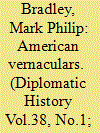

|
|
|
|
|
| Publication |
2014.
|
| Summary/Abstract |
On a wintry January evening in 1973, the members of Amnesty International USA Group 11 gathered on the Upper East Side of New York City to adopt a new prisoner of conscience, Sutanti Adit of Indonesia. Adit, a medical doctor and the wife of the leader of the Indonesian Communist Party, had been arrested and imprisoned in the ruthless campaigns of repression that followed a failed 1965 coup against the Sukarno government, which had ruled Indonesia since its formal independence from Dutch colonial control in 1950. She was among more than a hundred thousand Indonesians arrested, interrogated (often under torture), and imprisoned by the state. As many as fifty thousand of them remained in custody for more than a decade housed in prison camps whose sanitation, medical facilities, and food were inadequate at best. They were permitted very limited contact with the outside world, including family and friends, and harshly mistreated by prison guards.1
|
|
|
|
|
|
|
|
|
|
|
|
|
|
|
|
| 2 |
ID:
132032
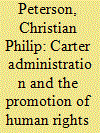

|
|
|
|
|
| Publication |
2014.
|
| Summary/Abstract |
This article will examine the effectiveness of the Carter administration's efforts to promote human rights in the Soviet Union. It will pay particular attention to how human rights promotion fit into a larger approach to transforming Superpower relations in ways favorable to U.S. interests called "reciprocal accommodation [détente]." The use of this framework provides an excellent way to tease out the complexities of how the administration balanced the promotion of human rights in the USSR with other important objectives such as concluding the SALT II treaty. It also helps reveal how executive branch worked to reduce Soviet human rights violations by citing the provisions of the Final Act and working with private citizens to raise international awareness about human rights issues. Without losing sight of his administration's inability to protect Soviet dissenters from arrest and harassment, this article will demonstrate that Carter had every intention of making the issue of human rights an important element of Cold War competition and implementing a new approach to détente that at least in part aimed at transforming Soviet internal behavior.
|
|
|
|
|
|
|
|
|
|
|
|
|
|
|
|
| 3 |
ID:
177568
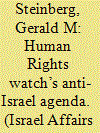

|
|
|
|
|
| Summary/Abstract |
The influence of Human Rights Watch (HRW) is reflected in the organisation’s intense involvement in institutions that emphasise human rights, including the United Nations and the International Criminal Court. However, HRW and its leaders have been strongly criticised for intense political and ideological bias against Israel and for proliferating unsubstantiated accusations to fit this bias. This article documents the role of Kenneth Roth, Executive Director since 1993, in this politicisation. Roth’s direct involvement with Israel-focused activities is fundamentally different from his role on other topics and countries on HRW’s agenda, and contrasts strongly with norms of universality and political neutrality.
|
|
|
|
|
|
|
|
|
|
|
|
|
|
|
|
| 4 |
ID:
132431
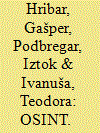

|
|
|
|
|
| Publication |
2014.
|
| Summary/Abstract |
Open Source Intelligence (OSINT) is generally seen in positive terms, particularly as a method of conventional intelligence collection that does not violate human rights. Of all the data collection methods, OSINT is, arguably, the only fully legal method. It can be conducted anytime, anywhere, and with any (legal) tools/software, as long as it does not violate human rights. In principle, however, OSINT does not and should not violate human rights, therefore such tools are all, again arguably, legal. Thus, its legality makes OSINT globally available, including to markets around the world. The free market offers various legal tools that facilitate the analytical procedures of data acquisition and analysis, and which no longer represent a major technical and logistical obstacle. Hypothetically, OSINT can be carried out by anyone with such specific tools and knowledge. These tools can be obtained by anyone free of charge or by paying for the licensed program, while the knowledge necessary to conduct OSINT is relatively easily acquired. Even though the tools and knowledge are freely accessible, the major difference between basic and excellent OSINT "operations" lies in the analytical process. Only experts with good analytical skills and knowledge manage to provide the right information at the right time to their customers/policymakers. OSINT is also a formal tool and means of analytical support in the work of intelligence services. Intelligence service analysts are capable of the advanced use of OSINT-they are familiar with specialized sources of specific data, advanced techniques of acquiring data, and the analytical steps needed for successful processing, exploitation, and analysis of massive amounts of data. The exploitation of special sources and the use of advanced techniques make OSINT questionable when seen through the prism of legality. The exploitation is at times semi-legal or even, arguably, illegal. The use of "special" techniques in OSINT can therefore lie on the edge between the legal and the illegal. These actions are sometimes clearly illegal, of course, and therefore forbidden by the criminal law; such practice by the intelligence services is not sanctioned. This raises the following questions: Could the intelligence services using OSINT in a legal manner to serve their specific individual interests interfere in another country on the ground of this same legality? Without this hypothetical "grey zone" would they be acting illegally and so become subject to counterintelligence observation?
|
|
|
|
|
|
|
|
|
|
|
|
|
|
|
|
| 5 |
ID:
127546
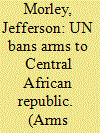

|
|
|
|
|
|
|
|